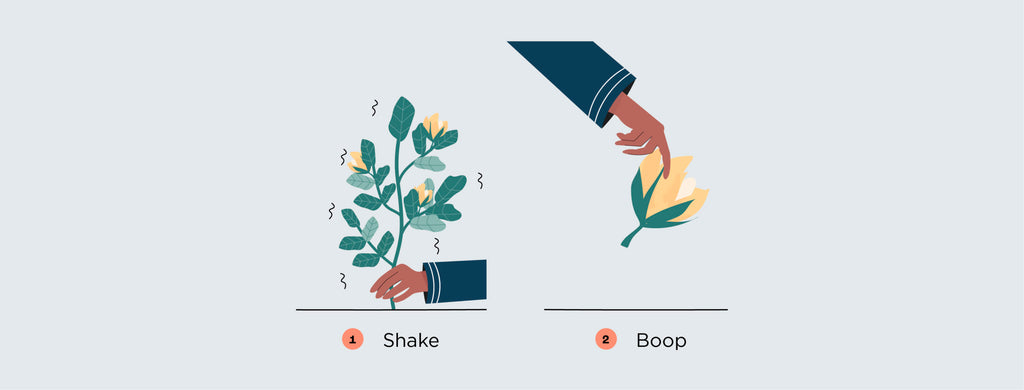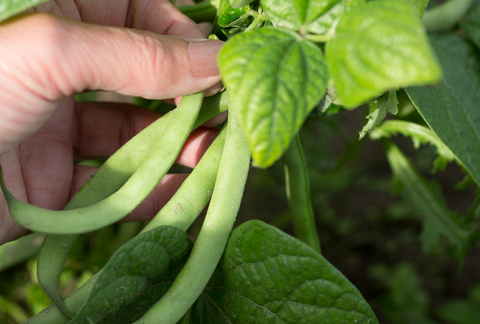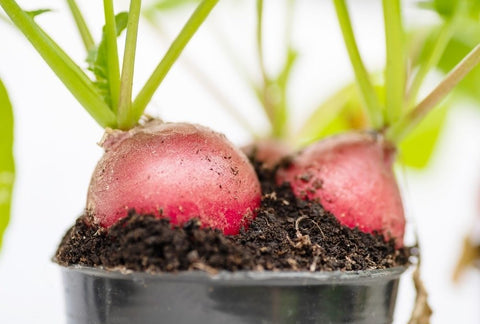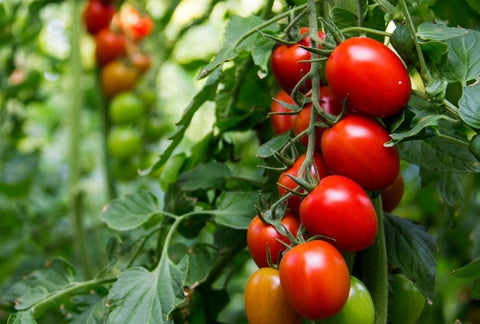Freaky fact: Some ancient cults believed that souls traveled through the stems of bean plants on their way to be reincarnated into their next life (so it was a sin to eat, or even walk among bean plants).

Timing
Sprouts in 1-2 weeks. Harvest from Week 6 on.

Full sun
Equivalent of 6+ hours of direct sun [DLI of 18+ mol/m²/day].

Care
Beginner-friendly. Once it’s producing – you’ll have to harvest it every couple of days.
Best Bean Varieties to Grow Indoors
Beans come in many colors – yellow, purple, and of course green. Unlike other vegetables, most beans taste pretty similar (except for asparagus yard long – which is a bit mushroomy). The biggest difference in selecting beans to grow indoors is the size and pollinating requirements. Beans grow in two types: bush beans and pole beans. Pole beans grow very tall (like 10 feet!) so you’re usually better off sticking with bush beans. Most are self-pollinating, but there are ones that need hand pollination (which is a pain with beans) so we recommend avoiding them. Our favorites are:
Tendercrop
String
The quickest of the beans, with a big yield, good flavor, and the classic shape.
AmazonPurple Queen
Purple String
This is quite the looker with strong purple coloring on its pods, leaves, and flowers.
AmazonDwarf Bees
Runner Bean
One of the most compact beans – it tops out just under 2 feet tall with beautiful red flowers.
AmazonBest Setup for Bean Plants
You’ll need:
Planter:
Ceramic Self Watering Planter (preferred) or pot that is at least 8″ / 1 gal.
Soil:
Standard Potting Mix
Plant Food:
At the start: Herb Blend. This should be high in nitrogen (with NPK numbers like 10-5-5).
Ongoing: Vegetable Blend. This should be high in phosphorus and low in nitrogen (with NPK numbers like 4-10-6).
Grow Light:
A strong grow light that can give the equivalent of 6+ hours of direct sun [DLI of 18+ mol/m²/day].
Jump to: Our product recommendations
Preparing Your Planter & Watering Schedule for Beans
Beans do well in moist soil conditions. If the soil dries out completely the roots will die back and it will be tough for the plant to recover. On the other hand, if the roots are exposed to standing water for too long, they can rot.
A Ceramic Self Watering Planter filled with a standard potting mix self-regulates to keep the soil at consistent moisture for your plant to thrive (and no watering guesswork for you).
To set one up:

- Fill up the planter with dry soil from the bag, gently tamping down the top.
- Dump the soil into a large mixing bowl and add water until the soil is moist, but not sopping wet (about ½ cup).
- Mix in 1 tablespoon of the Herb Blend Plant Food.
If you are using a regular pot instead, it should be a little bit bigger (at least 8″ / 1 gal) and have drainage holes to prevent it from being over watered. Let the top of the soil dry out between watering.
Starting Your Beans: Seed vs. Propagate
Beans are best started from seed in the area they will grow to their full size (known as “direct sowing”). They don’t handle transplanting well and tend to grow quicker from seed than propagating from a cutting – so we recommend starting them from seed.
How to Plant Bean Seeds

Beans grow quickly from seed. Plant 4 sites in an 8″ / 1 gal container. In larger containers, space sites 2″ apart. For each site, plant 2 seeds 1″ deep. Keep the soil warm (75-95°F, ideally 80°F). Sprouts typically appear in 9 days but can be as quick as 4 days or as long as 14 days depending on your conditions.
While you should take advantage of the sun (it’s free and perfect for plants), there are limited circumstances where indoor natural light is enough for bean plants to grow well. A very bright window can cut your grow light needs in half, but if you want to grow lots of beans, you’ll still need one. For an introduction to grow lights, head over to our post on grow lights for indoor gardeners. We’ve also got a buying guide for screw-in types, but to keep things simple in this guide, we’ll just provide directions for the 24W Screw-in Bulb by Sansi, which we think is a good middle-of-the-road option.

How bright should your grow light be?
Beans plants need the equivalent of 6+ hours of direct sunlight [DLI of 18+ mol/m²/day] to grow their best. In order to provide an equivalent amount with a grow light, it needs to be pretty bright! The 24W Sansi bulb should be placed 6 inches away from the top of the plant. This will give your PPFD (the standard measure of brightness) of 500 μmol/m²/s.
How many hours per day do your Beans need under a grow light?
Beans plants are what’s known as “day-neutral” so can grow under a range of daylight lengths. In order for them to get enough light, we recommend setting up a timer to leave it on for 12+ hours per day.
Beans Plants Grow Faster in Warmer Temps
Beans plants are called “warm-weather crops” and like temperatures right around 80°F. They will grow fine in conditions between 60 and 90°F but can lose their fruit if it drops below 40°F. On the other hand, if they are too hot, they will drop their blossoms, wilt, and stop ripening. Most homes are in a good range – and a south-facing sunny window can help get a plant the extra heat if needed.
Week 1-2: Check for Sprouts
You could see seedlings in as little as 4 days (though 9 days is more typical). If it’s been 14 days and you still don’t have any sprouts, it’s likely that your setup is too cold.
Week 3: Thin Your Seedlings

Thin your planter to only have 1 seedling per site – leaving the largest plant. If you are using the recommended planter (at least 8″ / 1 gal) this will mean you’ve got 4 plants after thinning. By getting rid of the smaller seedlings, you’re allowing the biggest and strongest one to flourish by reducing its competition for water, food, and space.
If your seedlings are under 2 inches, stretching out, or folding over, it’s likely that they don’t have quite enough light.
Week 4: How to Prune and Trellis Beans
You don’t need to do any pruning outside of removing yellowing leaves, although you may want to cut certain parts back to fit your space. Beans generally grow as bushes and can support themselves – but if they are looking weak they can benefit from a stake along the main stem.
Week 5+: How to Pollinate Your Beans Flowers

Beans are self-fruitful, so there is no need to pollinate the flowers. After the flowers form, it generally takes 2 weeks until they are ready to pick.
Week 6: How to Harvest Beans
The rule for these is to “pick them often and pick them all.” Beans are at peak sugar stage for a short time, so you need to pick often to catch the small window of the best flavor. When vegetables start to form it’s helpful to experiment a bit to find out what they are like at peak flavor for you. If you miss a single bean (and they’re good at hiding!) and it grows to maturity then these plants end their life cycle early. By preventing the plant from finishing that last step of making seeds, you are able to keep it producing vegetables for much longer.
Month 12+: End of Life
As long as conditions are cool and you don’t miss any harvests, your bean plant can keep producing for over a year.
Shop This Blog
The right supplies can take the guesswork out of caring for your plants – and turn care from a daily to weekly routine. Through our grow tests, we’ve found these products to produce the best indoor Beans (and also have simple maintenance). Plants are adaptable and can grow in many different conditions, so they are by no means necessary if you already have other supplies.
Best Containers for Beans: Ceramic Self Watering Planters
Plants thrive on consistent moisture but can suffer if they’re waterlogged. A semi-porous ceramic self-regulates ideal conditions. Our favorite is the COSWIP planter. Runner up is the XS Self Watering Planter by Wet Pot.
Best Soil for Beans: Standard Potting Mix
Beans like a rich and moist root zone – so you are best off with a standard potting mix – we like this Potting Mix by Rosy Soil.
Best Nutrients for Beans: Balanced Blend followed by Vegetable Blend
Beans like to start with nutrients that are high in nitrogen (with NPK numbers like 10-5-5). For this Herb Blend, we recommend Joyful Dirt All Purpose.
Once they are growing, it’s better to use plant food that is high in phosphorus and low in nitrogen (with NPK numbers like 4-10-6). For this Vegetable Blend, we recommend Joyful Dirt Tomato & Herb.
Best Light for Beans: DIY or Soltech
There is a very small chance that you have the bright windows needed to grow these without a grow light. If you are looking for a higher-end option, we love the Aspect Light by Soltech. For a more affordable option, a DIY setup using a 24W Screw-in Bulb by Sansi with a Clamp Light and Timer works well too. Check out our complete guide on a DIY setup for less than $40 or our buying guide for screw-in bulbs.








There are no comments for this article. Be the first one to leave a message!